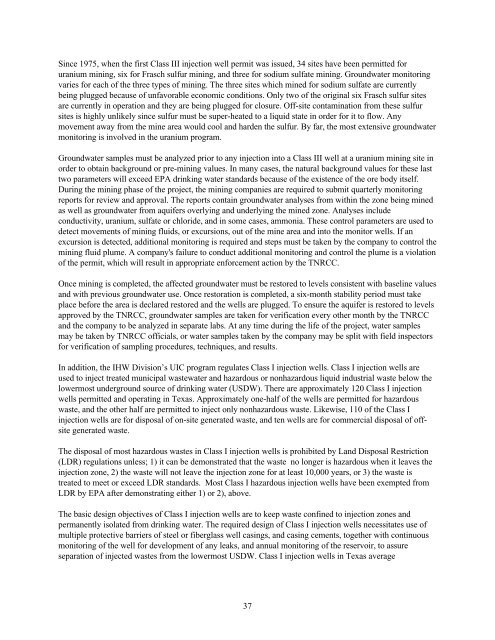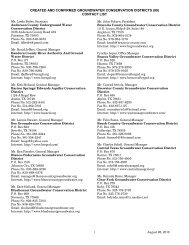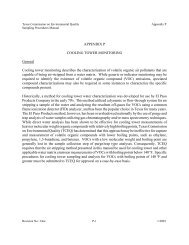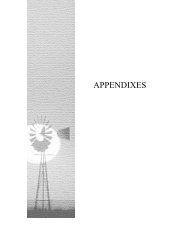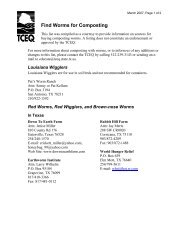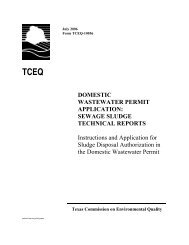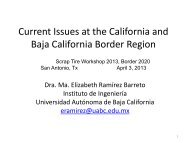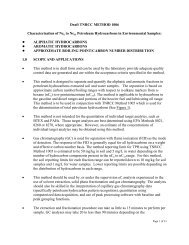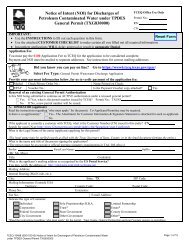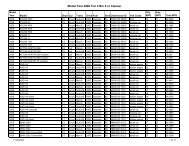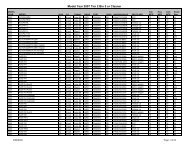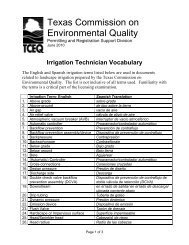joint groundwater report - Texas Commission on Environmental ...
joint groundwater report - Texas Commission on Environmental ...
joint groundwater report - Texas Commission on Environmental ...
Create successful ePaper yourself
Turn your PDF publications into a flip-book with our unique Google optimized e-Paper software.
Since 1975, when the first Class III injecti<strong>on</strong> well permit was issued, 34 sites have been permitted foruranium mining, six for Frasch sulfur mining, and three for sodium sulfate mining. Groundwater m<strong>on</strong>itoringvaries for each of the three types of mining. The three sites which mined for sodium sulfate are currentlybeing plugged because of unfavorable ec<strong>on</strong>omic c<strong>on</strong>diti<strong>on</strong>s. Only two of the original six Frasch sulfur sitesare currently in operati<strong>on</strong> and they are being plugged for closure. Off-site c<strong>on</strong>taminati<strong>on</strong> from these sulfursites is highly unlikely since sulfur must be super-heated to a liquid state in order for it to flow. Anymovement away from the mine area would cool and harden the sulfur. By far, the most extensive <str<strong>on</strong>g>groundwater</str<strong>on</strong>g>m<strong>on</strong>itoring is involved in the uranium program.Groundwater samples must be analyzed prior to any injecti<strong>on</strong> into a Class III well at a uranium mining site inorder to obtain background or pre-mining values. In many cases, the natural background values for these lasttwo parameters will exceed EPA drinking water standards because of the existence of the ore body itself.During the mining phase of the project, the mining companies are required to submit quarterly m<strong>on</strong>itoring<str<strong>on</strong>g>report</str<strong>on</strong>g>s for review and approval. The <str<strong>on</strong>g>report</str<strong>on</strong>g>s c<strong>on</strong>tain <str<strong>on</strong>g>groundwater</str<strong>on</strong>g> analyses from within the z<strong>on</strong>e being minedas well as <str<strong>on</strong>g>groundwater</str<strong>on</strong>g> from aquifers overlying and underlying the mined z<strong>on</strong>e. Analyses includec<strong>on</strong>ductivity, uranium, sulfate or chloride, and in some cases, amm<strong>on</strong>ia. These c<strong>on</strong>trol parameters are used todetect movements of mining fluids, or excursi<strong>on</strong>s, out of the mine area and into the m<strong>on</strong>itor wells. If anexcursi<strong>on</strong> is detected, additi<strong>on</strong>al m<strong>on</strong>itoring is required and steps must be taken by the company to c<strong>on</strong>trol themining fluid plume. A company's failure to c<strong>on</strong>duct additi<strong>on</strong>al m<strong>on</strong>itoring and c<strong>on</strong>trol the plume is a violati<strong>on</strong>of the permit, which will result in appropriate enforcement acti<strong>on</strong> by the TNRCC.Once mining is completed, the affected <str<strong>on</strong>g>groundwater</str<strong>on</strong>g> must be restored to levels c<strong>on</strong>sistent with baseline valuesand with previous <str<strong>on</strong>g>groundwater</str<strong>on</strong>g> use. Once restorati<strong>on</strong> is completed, a six-m<strong>on</strong>th stability period must takeplace before the area is declared restored and the wells are plugged. To ensure the aquifer is restored to levelsapproved by the TNRCC, <str<strong>on</strong>g>groundwater</str<strong>on</strong>g> samples are taken for verificati<strong>on</strong> every other m<strong>on</strong>th by the TNRCCand the company to be analyzed in separate labs. At any time during the life of the project, water samplesmay be taken by TNRCC officials, or water samples taken by the company may be split with field inspectorsfor verificati<strong>on</strong> of sampling procedures, techniques, and results.In additi<strong>on</strong>, the IHW Divisi<strong>on</strong>’s UIC program regulates Class I injecti<strong>on</strong> wells. Class I injecti<strong>on</strong> wells areused to inject treated municipal wastewater and hazardous or n<strong>on</strong>hazardous liquid industrial waste below thelowermost underground source of drinking water (USDW). There are approximately 120 Class I injecti<strong>on</strong>wells permitted and operating in <str<strong>on</strong>g>Texas</str<strong>on</strong>g>. Approximately <strong>on</strong>e-half of the wells are permitted for hazardouswaste, and the other half are permitted to inject <strong>on</strong>ly n<strong>on</strong>hazardous waste. Likewise, 110 of the Class Iinjecti<strong>on</strong> wells are for disposal of <strong>on</strong>-site generated waste, and ten wells are for commercial disposal of offsitegenerated waste.The disposal of most hazardous wastes in Class I injecti<strong>on</strong> wells is prohibited by Land Disposal Restricti<strong>on</strong>(LDR) regulati<strong>on</strong>s unless; 1) it can be dem<strong>on</strong>strated that the waste no l<strong>on</strong>ger is hazardous when it leaves theinjecti<strong>on</strong> z<strong>on</strong>e, 2) the waste will not leave the injecti<strong>on</strong> z<strong>on</strong>e for at least 10,000 years, or 3) the waste istreated to meet or exceed LDR standards. Most Class I hazardous injecti<strong>on</strong> wells have been exempted fromLDR by EPA after dem<strong>on</strong>strating either 1) or 2), above.The basic design objectives of Class I injecti<strong>on</strong> wells are to keep waste c<strong>on</strong>fined to injecti<strong>on</strong> z<strong>on</strong>es andpermanently isolated from drinking water. The required design of Class I injecti<strong>on</strong> wells necessitates use ofmultiple protective barriers of steel or fiberglass well casings, and casing cements, together with c<strong>on</strong>tinuousm<strong>on</strong>itoring of the well for development of any leaks, and annual m<strong>on</strong>itoring of the reservoir, to assureseparati<strong>on</strong> of injected wastes from the lowermost USDW. Class I injecti<strong>on</strong> wells in <str<strong>on</strong>g>Texas</str<strong>on</strong>g> average37


